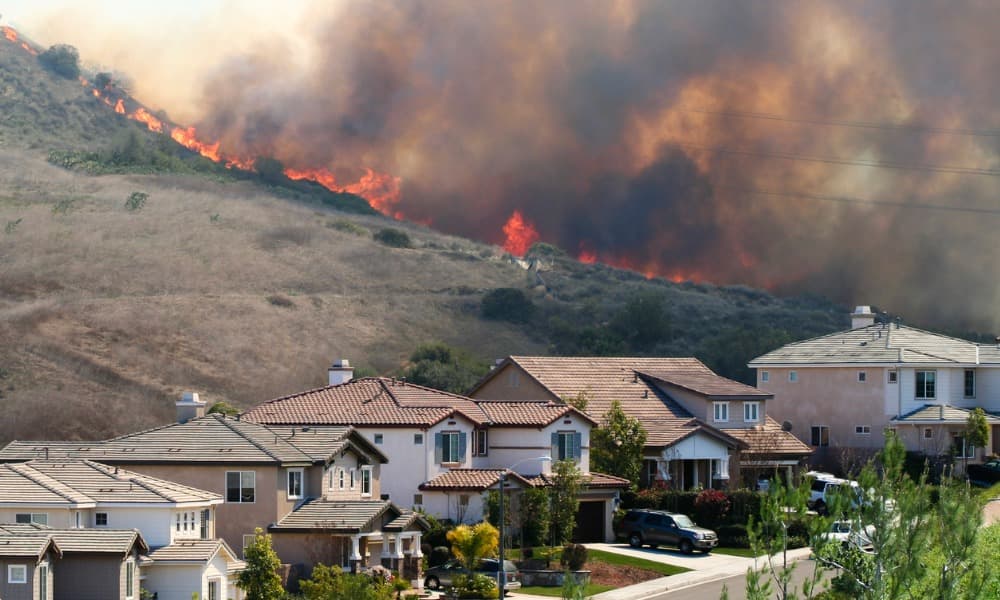Following a few simple tips can help keep your communities safe during wildfire season and throughout the year.
Key takeaways:
- Wildfires threaten many parts of the country
- Developing a fire-smart landscaping strategy can reduce your risk
- This strategy involves limiting the fuel a fire can consume in your communities
- Community managers should be proactive in protecting neighborhood homes and residents
Wildfires are a significant problem in many parts of the United States, particularly in dry climates with significant vegetation for the fires to consume. According to the National Interagency Fire Center, 2022 saw 68,988 wildfires burn over 7.5 million acres of land, nearly the equivalent of the entire state of Maryland.
The Multi-Resolution Land Characteristics Consortium’s National Land Cover Database reports that almost 60% of the country’s land is made up of forests, shrubland, or grassland, giving fires plenty of room to burn. As a result, homeowners and community managers must do everything in their power to minimize their risk, particularly in California and other western states where wildfires are most prevalent.
Minimizing your risk starts with developing a fire-smart landscaping plan. What is fire-smart landscaping? Here’s an answer to that question and some techniques you can incorporate into the communities you manage.
What is fire-smart landscaping?
In short, fire-smart landscaping involves incorporating fire-resistant elements into your community’s outdoor design. It can include choosing plants that won’t burn as quickly as others, utilizing bricks and pavement, and keeping vegetation as far away from structures as possible.
The goal is to make it more challenging for fire to infiltrate the communities you manage by eliminating as much of the fuel it needs to burn as possible. While these strategies won’t necessarily stop a fire in its tracks, they could slow it down enough that crews can save your community if a wildfire ever gets close. Following a few tips can help you form a layer of protection around your HOA or condo complex.
Select fire-resistant plants
The plants you select when landscaping the property influence its fire resistance significantly. You’ll want to avoid coniferous trees like junipers, spruce, and pine because their needles burn fast and hot, helping fires spread.
Instead, consider deciduous trees that don’t have needles and don’t produce much dead wood. Plants such as cacti, succulents, lavender, iris, sedum, and lilac are also helpful because they have significant moisture in their leaves and grow low to the ground.
Plant placement is another vital concept because you’ll want vegetation as far as possible from the structures in your communities. While residents will probably have flowers and grass outside their homes, planting larger bushes and trees further from these buildings creates a barrier between a fire and the community’s houses.
Use bricks or pavement dividers
Brick and pavement won’t burn, so establishing dividers using these materials can limit the damage if a wildfire enters your community. Installing brick pathways between plants creates a small barrier that can buy some time, while pavement walks do the same.
Your community management fire-smart strategy could incorporate natural elements into your design. Boulders, for instance, take up space and act as a barrier, which can provide better outcomes if a fire should occur.
Remember, you won’t stop a massive wildfire completely. The goal is to slow it down so it doesn’t engulf your entire community. Using these fire-smart landscaping techniques eliminates some of the fuel the fire would need to spread rapidly, potentially limiting the damage.
Keep vegetation low
Low-growing plants provide less fuel for the fire to burn, making the entire community safer. The same goes for grass, particularly during a drought when it gets dried out.
You’ll want to do everything possible to keep your vegetation low by planting items that don’t grow too high and regularly trimming grass and weeds. Pruning trees, especially as they begin to overhang community houses, can work wonders, too, by creating space between fuel for a fire and the homes in your community.
Clean up dead branches and leaves
Dead branches and leaves aren’t just an eyesore, they’re premium wildfire fuel. So you don’t ever want to leave them lying around your communities. It’s best to remove any dead wood you see immediately and rake up dead leaves as often as necessary.
Clipping dead branches from the trees and shrubs in your neighborhoods can be a significant job, but it’s worth it because of its value as a fire-prevention method. You can also hire landscaping contractors to complete this work, eliminating a massive project from your workload.
Tame your slopes
If your community sits in a hilly area or backs onto a mountain, your fireproofing job becomes more complex. You’ll have to develop a strategy to tame these slopes and integrate fire-smart landscaping techniques into the plan.
Taming these slopes could involve installing retaining walls on the hills in your community to create a barrier for potential fires that will stop them from spreading up or down the slope. Retaining walls also give you a spot to plant fire-resistant vegetation in these locations.
Hills are challenging to mow, so many people tend to let them go, which can create a fire hazard. A retaining wall installation makes mowing and maintaining these areas easier, hopefully reducing the fuel available for a fire.
Hire fire-smart contractors
Community management in California and other wildfire-prone states has unique challenges because of the risks these disasters can bring. Hiring contractors with experience in plant selection, plant placement, and other fire-smart landscaping techniques makes your life easier as you attempt to keep the structures and people in your communities safe.
VendorSmart can put you in touch with expert contractors who understand the importance of fire-smart landscaping in your communities. We’ll vet these contractors before you hire them and ensure you can manage your entire relationship through our vendor management platform, streamlining the whole situation. Contact VendorSmart for more information on our vendor sourcing, compliance, and management solutions for community managers.
